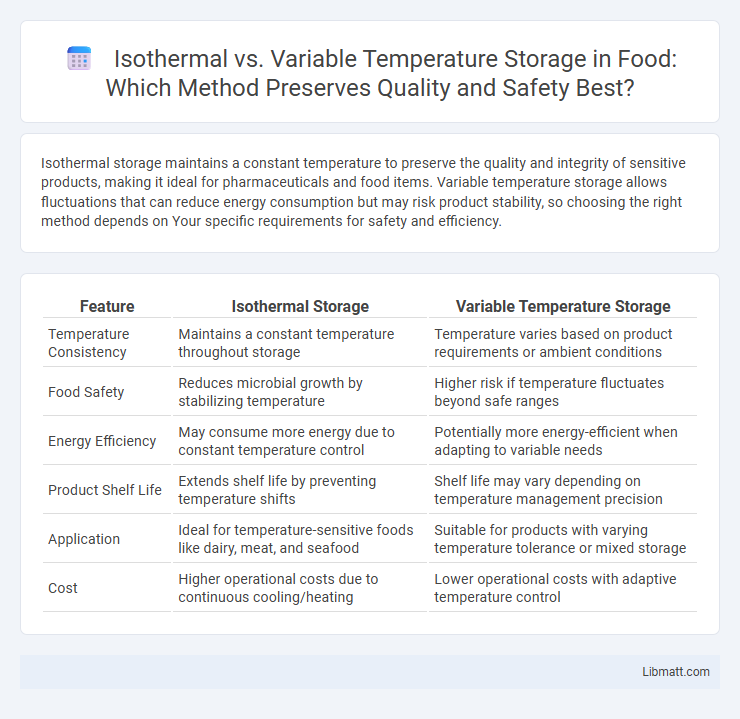Isothermal storage maintains a constant temperature to preserve the quality and integrity of sensitive products, making it ideal for pharmaceuticals and food items. Variable temperature storage allows fluctuations that can reduce energy consumption but may risk product stability, so choosing the right method depends on Your specific requirements for safety and efficiency.
Table of Comparison
| Feature | Isothermal Storage | Variable Temperature Storage |
|---|---|---|
| Temperature Consistency | Maintains a constant temperature throughout storage | Temperature varies based on product requirements or ambient conditions |
| Food Safety | Reduces microbial growth by stabilizing temperature | Higher risk if temperature fluctuates beyond safe ranges |
| Energy Efficiency | May consume more energy due to constant temperature control | Potentially more energy-efficient when adapting to variable needs |
| Product Shelf Life | Extends shelf life by preventing temperature shifts | Shelf life may vary depending on temperature management precision |
| Application | Ideal for temperature-sensitive foods like dairy, meat, and seafood | Suitable for products with varying temperature tolerance or mixed storage |
| Cost | Higher operational costs due to continuous cooling/heating | Lower operational costs with adaptive temperature control |
Introduction to Storage Temperature Methods
Isothermal storage maintains a constant temperature throughout the storage period, which helps preserve the stability and quality of temperature-sensitive materials such as pharmaceuticals and biological samples. Variable temperature storage involves fluctuations in temperature, often to optimize energy use or accommodate differing storage requirements, but it can risk degradation or reduced shelf life of sensitive products. Choosing between isothermal and variable temperature storage depends on the specific temperature sensitivity and stability requirements of the stored items.
Defining Isothermal Storage
Isothermal storage refers to the practice of maintaining a constant temperature environment to preserve sensitive materials, such as biological samples, pharmaceuticals, or perishable goods. This method minimizes temperature fluctuations, reducing the risk of degradation and ensuring stable quality over time. In contrast, variable temperature storage allows for temperature changes, which can compromise product integrity if not carefully managed.
Understanding Variable Temperature Storage
Variable temperature storage allows for fluctuations in temperature to meet specific product requirements, optimizing energy consumption and reducing operational costs compared to isothermal storage. This method leverages advanced insulation and environmental controls to maintain temperature ranges rather than fixed points, improving the shelf life and quality of sensitive goods. Understanding variable temperature storage involves analyzing temperature stability, humidity control, and energy efficiency metrics to balance product safety and cost-effectiveness.
Key Differences Between Isothermal and Variable Temperature Storage
Isothermal storage maintains a constant temperature to preserve sensitive materials, preventing thermal degradation and ensuring stability over time. Variable temperature storage fluctuates within a set range, accommodating different preservation needs but potentially exposing contents to temperature-induced stress. The key difference lies in temperature consistency, impacting the longevity and quality of stored items.
Advantages of Isothermal Storage
Isothermal storage maintains a constant temperature, reducing thermal stress and improving the lifespan of stored materials, especially in sensitive applications like pharmaceuticals and food preservation. It enhances energy efficiency by minimizing the need for frequent temperature adjustments, which lowers operational costs and environmental impact. Your products benefit from stable conditions, ensuring higher quality and safety during storage periods compared to variable temperature storage systems.
Benefits of Variable Temperature Storage
Variable temperature storage offers enhanced flexibility by adapting to fluctuating environmental conditions, which helps extend the shelf life of temperature-sensitive products such as pharmaceuticals and perishable foods. This dynamic approach optimizes energy consumption and reduces operational costs by allowing targeted cooling or heating only when necessary. You can achieve better preservation outcomes and improved product quality by leveraging real-time temperature adjustments.
Applications and Use Cases
Isothermal storage systems maintain a constant temperature ideal for pharmaceuticals, biological samples, and perishable food products, ensuring stability and extended shelf life during transportation and storage. Variable temperature storage adapts to fluctuating temperature requirements, making it suitable for industrial processes, cold chain logistics, and research environments where diverse materials require different thermal conditions. These applications highlight isothermal storage's reliability in preserving sensitive goods and variable temperature storage's flexibility for complex multi-temperature workflows.
Energy Efficiency and Cost Comparison
Isothermal storage systems maintain a constant temperature, resulting in lower energy consumption due to minimal heat loss, enhancing overall energy efficiency compared to variable temperature storage that requires additional energy to adjust temperatures frequently. Variable temperature storage incur higher operational costs because of continuous thermal regulation, while isothermal systems provide cost savings through reduced energy demand and maintenance. Your long-term investment benefits from isothermal storage's superior energy efficiency and lower total cost of ownership.
Challenges and Limitations
Isothermal storage systems face challenges such as high energy consumption and reliance on advanced insulation materials to maintain constant temperatures, increasing operational costs. Variable temperature storage struggles with uneven cooling or heating, leading to temperature fluctuations that can degrade product quality and reduce shelf life. Both methods are limited by scalability issues and sensitivity to external environmental conditions, impacting overall efficiency and reliability.
Choosing the Right Storage Solution
Isothermal storage maintains a constant temperature, ideal for preserving sensitive materials such as pharmaceuticals and biological samples by minimizing thermal fluctuations and degradation. Variable temperature storage offers flexibility for items with broader temperature tolerances, optimizing energy efficiency and cost where strict temperature control is unnecessary. Selecting the appropriate storage solution depends on the specific temperature sensitivity, stability requirements, and budget constraints of the stored products.
isothermal storage vs variable temperature storage Infographic

 libmatt.com
libmatt.com